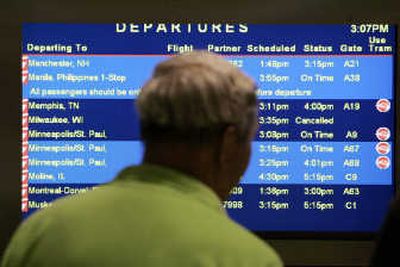Season ranks among worst for air travel

CHICAGO – The evidence is quickly adding up: After more than a decade of troubled air travel, the summer of 2007 may be the most tortured yet, with congestion growing daily, and more frequent meltdowns that ripple across the nation, stranding passengers for days.
The airlines’ on-time arrival performance in the first five months of this year was the worst in 13 years, the U.S. Department of Transportation reported last week. And that was before the weather got really bad.
Nor do the statistics capture the most distinctive dynamic of this summer’s air woes – the moments when the nation’s hub-and-spoke network of airports seem to seize up altogether, causing passengers to miss not just one flight, but the next and next and many more, because planes are full, or grounded, or both.
Some of the ingredients in this stew of frustration are familiar, such as a burst of bad weather in June that shut down hub after hub, and the labor troubles dogging some airlines.
Some are quirky, such as unrelated computer outages at the Federal Aviation Administration on June 8 and at United Airlines 12 days later.
But some result from attempts by the airlines to scratch out profits after years of losses, conditions that may not improve any time soon.
With a record 209 million passengers projected to pass through the nation’s airports this summer, airlines are trying to keep airplanes as full as possible. When it works, the airlines make a modest profit and passengers get low-priced fares. But when things go wrong, airlines have little room to maneuver, and delays and cancellations multiply quickly.
As they keep a lid on costs, airlines have also postponed buying new planes, while keeping flight and ground crews to a minimum. When a plane breaks down, or a pilot calls in sick, flights are often scrubbed and the dominoes start falling again.
The FAA, too, is operating close to capacity, using aging technology that can barely handle the growing volume of traffic. Even on a blue-sky day, air-traffic controllers must sometimes create intentional delays to avoid being overwhelmed.
“It has been a horrendous summer, with flight delays rippling nationwide like never before and fears of having entire airline networks unravel,” said Joseph Schwieterman, an airline expert at DePaul University.
“A canceled flight could mean a two-day wait instead of waiting for the next flight because so many flights leave full and there is no extra capacity,” added Schwieterman, a former airline pricing analyst. “This is the new reality for travelers.”
Flight delays are costing the struggling airlines $16 billion annually because of excess fuel consumption, inefficient use of aircraft and crews and other factors, according to the Air Transport Association, the trade group representing the major U.S. airlines. The vicious cycle of growing delays and higher operating costs will only increase the strain, according to the association, which sees no near-term improvements.
A busy, stormy summer in 2000 led to similar spasms of gridlock, threatening to suffocate the commercial aviation system. But the 2001 terrorist attacks drove passengers away, alleviating the crowding while sending the airlines’ business into a tailspin.
Since then, the airlines have cut back and customers have returned. The number of individual trips by passengers has increased 12 percent since 2000, to 744 million, while the ranks of full-time airline employees have shrunk 36 percent.
And some airlines seemed unprepared for the speed at which a moderate disruption can now cascade into a full-blown crisis.
JetBlue Airways was caught flat-footed in February when an ice storm in the Northeast paralyzed the airline for almost a week, forcing more than 1,100 flight cancellations. JetBlue chief executive officer David Neeleman apologized profusely for poor customer service and offered travel vouchers to delayed passengers. But many stranded fliers vowed to never fly the low-cost airline again.
Northwest Airlines canceled about 1,000 flights in late June – inconveniencing tens of thousands of travelers – due in large part to pilot absenteeism, which was 80 percent higher than it was in June 2006, the airline said. Northwest emerged from Chapter 11 bankruptcy protection on May 31 and its pilots are still angry over wage cuts.
Northwest said it would reduce its schedule starting in August and take other actions to increase its reserve of pilot flying hours.
While land-based businesses often tout the strategy of keeping inventories at a minimum, the just-in-time principle does not always translate well for airlines. Still, industry officials say they have no choice, and warn passengers to get used to full planes and little margin for error. A last-minute passenger buying a full-fare ticket can be the difference between a flight operating in the red or the black.
“The carriers are doing what is right from the business perspective,” insisted David Castelveter, spokesman for the airline association. “We don’t have the luxury of having airplanes or employees sitting around waiting to deal with a disruption.”
“Customers are going to have to make some adjustments. It’s just no longer prudent for a passenger to take a morning flight to meet a cruise ship in the afternoon,” Castelveter said.
About 85 percent of available airline seats will be sold this year between June 1 through Aug. 31, according to the Air Transport Association. Some flights may have more space than that, but on popular routes, every seat will be filled, with 2 million more people flying than last summer.
Bad weather causes about 75 percent of flight delays, according to the FAA.
“June was a very tough weather month for Chicago, New York, Dallas and cities in Florida. There was severe weather on most days,” said Bob Everson, the FAA’s tactical operations director for the Midwest. “We’ve reduced air-traffic delays about 6 percent using a combination of new tools this year allowing planes to fly around thunderstorms.”